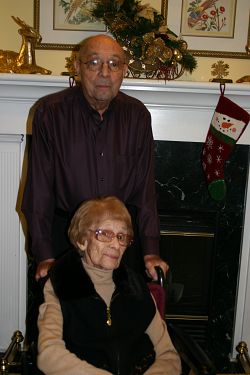Deacon Silvio and Mary Mayo celebrate 71 years of marriage, family and faith in Diocese of Salt Lake City
Friday, Jan. 09, 2015

Intermountain Catholic
+ Enlarge
Deacon Silvio and Mary Mayo met at Judge Memorial Catholic High School, and ?the rest is history,? said their son Monsignor Joseph Mayo.
IC photo/Christine Young
SALT LAKE CITY — December is a particularly special month for Chancellor emeritus Deacon Silvio Mayo and his wife Mary; they were married on Dec. 23, 1943, and they both celebrated their 90th birthday this year in December.
A marriage of 70 years requires a lot of patience and joint involvement in church and in other activities, “but at the same time having separate interests,” said Mary Mayo. “Our faith has been so important to us; the Church has always been our focal point. You don’t get a divorce just because something doesn’t go right.”
“We never thought of breaking up our marriage; we’ve taken the bitter with the sweet,” Deacon Mayo said. “You have to have a lot of tolerance. ... Mary was part of the diaconate activities.”
Deacon Mayo was ordained a permanent deacon in 1976; his first assignments were at Saint Francis Xavier and Saint Patrick parishes; he then was assigned to the Cathedral of the Madeleine.
Bishop William Weigand appointed Deacon Mayo Chancellor of the Diocese of Salt Lake City in 1985; he was the first person in the United States to be a non-priest chancellor. He retired in 2013.
During the years, Mary worked as a medical librarian doing coding for the various hospitals, and then worked in the diocesan communications office.
“Our children have helped us support each other and have been very good to us,” Deacon Mayo said.
The Mayos had three children: Robert Mayo, who died Jan. 8, 2014; Monsignor Joseph Mayo, pastor of Saint John the Baptist Parish in Draper; and Msgr. Mayo’s twin sister Joanne. They also have two grandsons and two great-grandchildren.
Deacon Mayo’s family moved from Carbon County to the west side of Salt Lake City when he was about 8 years old and became members of Our Lady of Guadalupe Mission.
“It was on 4th South by the viaduct and was predominantly Hispanic, Lebanese and English. The pastor was Father James Collins,” said Deacon Mayo. “There were a lot of immigrants who lived by the Rio Grande Depot and some who came from Saint Patrick Parish who were mostly Italian. The mission was two houses joined together, with a big ball field in the back.”
The mission was more than a church, said Deacon Mayo. “It was a gathering place and we spent all of our time there in summer school, catechism, playing bingo, watching movies; it was like a club, a family. We also had Our Lady of Perpetual Adoration Sisters who lived in one of the houses. Fr. Collins was innovative and he would do things to help us remember what we learned.”
Mary Mayo’s family moved to the west side of Salt Lake from Bingham, and “my parents wanted to go to the Guadalupe Mission,” she said. “I knew Silvio at Guadalupe Church, but we really got together at Judge Memorial High School.”
Deacon Mayo graduated a year ahead of Mary.
“I wanted to become a priest, but decided the seminary was too strict for me,” he said. “When they restored the diaconate in 1973, I was able to be an ordained deacon and be married.”
The couple married after Mary graduated from high school in 1943.
“We got married in the mission by Fr. Collins, and stayed in the same area and had our kids,” said Mary.
The depot was a “very hustle-and-bustle place in those days,” said Deacon Mayo. “I worked with my older brother, Joe, in the Macaroni Company on 400 West 300 South, and his house was next door to it; it was a gathering place for a lot of the immigrants, including Fortunato Anselmo, the Italian Counsel for Utah.”
Msgr. Mayo also fondly remembers his Uncle Joe’s and Aunt Mary Mayo’s home. “There were always clergy around our house and my Uncle Joe’s house. On Sunday nights there was always a priest in the house; they were always welcome,” Msgr. Mayo said. “My brother and I also served at Masses; we had priests at Judge, who also influenced my becoming a priest. Religious life in the 1960s until Vatican II was a very important leg of family life; getting dressed up in a coat and tie for church was what we did.
“My parents really learned their faith and the whole idea of serving from Fr. Collins and the sisters,” Msgr. Mayo said.
For questions, comments or to report inaccuracies on the website, please CLICK HERE.
© Copyright 2024 The Diocese of Salt Lake City. All rights reserved.
© Copyright 2024 The Diocese of Salt Lake City. All rights reserved.

Stay Connected With Us